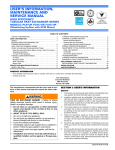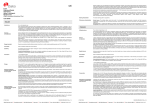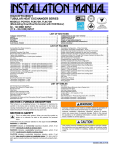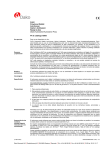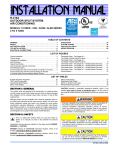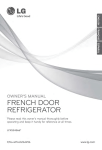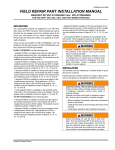Download Unitary products group 90% P DH Unit installation
Transcript
247589-UAI-B-0807 ACCESSORY KIT INSTALLATION INSTRUCTIONS 1NP0680 - PROPANE CONVERSION FOR USE WITH MODELS: PM8, PC8, PM9, PC9, FL9M, FL9C, FC9M, FC9C This conversion kit is to be installed by a qualified service agency in accordance with these instructions and all applicable codes and requirements of the authority having jurisdiction. If the information in these instructions is not followed exactly, a fire, an explosion or production of carbon monoxide may result causing property damage, personal injury or loss of life. The qualified service agency is responsible for the proper installation of this kit. The installation is not proper and complete until the operation of the converted appliance is checked as specified in these instructions supplied with the kit. The conversion of new certified central heating gas appliances must conform to directions outlined in this instruction. Installation must be made in accordance with American National Standard National Fuel Gas Code, ANSI Z223.1-latest edition, unless superseded by local codes. For Canadian installations, the conversion shall be carried out in accordance with the requirements of the Provincial authorities having jurisdiction and in accordance with the CAN1-B149.1 and .2 installation codes. The manufacturer accepts no responsibility for malfunctions due to improper conversions GENERAL This kit is intended for the conversion of new equipment only, from natural gas to propane gas operation, up to 8,000 feet. Over 8,000 feet, refer to the High Altitude Kit Instructions. This instruction covers the conversion of this unit when it is equipped with a White-Rodgers gas valve. The installation instruction supplied with the unit is to be used for all other aspects of the installation. Improper installation, adjustment, service or maintenance can cause injury or property damage; therefore, only a qualified installer or qualified service personnel should perform this conversion. NOTE: The original equipment gas valve on the furnace is not capable of being adjusted so as to operate on LP gas pressures. The new gas valve in this kit must be used. IMPORTANT - These instructions are for the use of qualified individuals specially trained, experienced and certified in the installation of this type of equipment and related systems components. Installation and service personnel are required by some states to be licensed. Persons not qualified shall not install this equipment nor interpret these instructions. Unitary Products Group This is a safety alert symbol. When you see this symbol on labels or in manuals, be alert to the potential for personal injury. Understand and pay particular attention to the signal words DANGER, WARNING, or CAUTION. DANGER indicates an imminently hazardous situation, which, if not avoided, will result in death or serious injury. WARNING indicates a potentially hazardous situation, which, if not avoided, could result in death or serious injury. CAUTION indicates a potentially hazardous situation, which, if not avoided may result in minor or moderate injury. It is also used to alert against unsafe practices and hazards involving only property damage. CONTENTS OF KIT DESCRIPTION PART NUMBER QTY Gas Line Pressure Switch 17471 1 Tapped Gas Pipe Nipple 18595 1 Modulating Gas Valve (Red Knob) 167246 1 Kit Installation Instruction 247589 1 Main Burner Orifices #55 18081 7 Wire Harness 20461 1 Label, Conversion Rating Plate 255649 1 Label, LP Conversion Kit 255424 1 Label, Conversion Kit 90% 255812 1 247589-UAI-B-0807 An overpressure protection device, such as a pressure regulator, which conforms to the National Fuel Gas code, ANSI Z223.1 (U.S.) or CAN-B149.1 or.2 (Canada) and acts to limit the downstream pressure to value that does not exceed 0.5 PSI (14" w.c.), must be installed in the gas piping system upstream of the furnace. Failure to do so may result in a fire or explosion or cause damage to the furnace or some of its components. FURNACE CONVERSION The gas supply shall be shut off prior to disconnecting the electrical power, before proceeding with the conversion. 1. Remove the upper access door. On 90% AFUE models, remove the burner box cover. 2. Carefully remove the wires from the gas valve and note their location so they may be properly replaced. Remove the screws that hold the manifold to the manifold brackets and slide the manifold off the burners. On 90% AFUE models, the manifold is retained by two screws at the bottom and hooks in at the top of the burner box. 3. Remove the natural gas valve from the manifold. 4. Install the LP gas valve from this kit, making sure that it is tight and in approximately the same position as the old valve. 5. 6. NOTE: The gas line pressure switch will cause the furnace to lock out if the gas supply pressure drops below 6” w.c. The ignition control will display a fault code 7 and will reset after one hour. 11. Disconnect the purple wire from the flame sensor. 12. Using the appropriate wire harness (supplied with kit) connect the purple wire from the flame sensor into the insulated male connector; connect the two 1/4” insulated terminals to the pressure switch; and connect the remaining insulated terminal to the flame sensor. 13. Install the propane gas conversion label as described in the LABELS section of this instruction. 14. Refer to the unit installation instructions to complete the installation before continuing with these procedures. TESTS AND ADJUSTMENTS CALCULATING THE FURNACE INPUT (NATURAL GAS) NOTE: Burner orifices are sized to provide proper input rate using natural gas with a heating value of 1030 BTU/Ft3 (38.4 MJ/m3). If the heating value of your as is significantly different, it may be necessary to replace the orifices. NOTE: Front door of burner box must be secured when checking gas input. 1. Turn off all other gas appliances connected to the gas meter. Remove the main burner orifices from the manifold and retain for future use. 2. At the gas meter, measure the time (with a stop watch) it Install the propane main burner orifices in the manifold and tighten them. After installing a propane orifice in each location, any leftover orifices may be discarded. If a stainless steel burner kit was purchased, refer to the kit instructions for the burner change out. 3. 7. Reinstall the manifold in the assembly by reversing the removal process. 8. Reconnect the wires to the proper terminals on the gas valve. 9. When installing gas piping on PM8/PC8 units, insert tapped gas pipe nipple (supplied with kit) into inlet fitting of gas valve. If using the right side cabinet knock out, the nipple can be either be installed before or after making the u-bend. On 90% AFUE models, install a field provided elbow into the inlet fitting on the gas valve and then install the tapped gas pipe nipple. 2 10. Install (thread) the gas line pressure switch (supplied with kit) into the 1/8 NPT tapped hole in nipple applying pipe dope to the switch fitting prior to installation. Tighten the switch making sure the connection does not leak. takes to use 2 cubic ft. (0.0566 m3) of gas. Calculate the furnace input by using one of the following equations. CALCULATING THE FURNACE INPUT (PROPANE GAS) NOTE: Burner orifices are sized to provide the proper input rate using propane gas with a heating value of 2500 BTU/Ft3. If the heating value of your gas is significantly different, it may be necessary to replace the orifices with different size orifices. Follow the procedure below to calculate the furnace input. 1. Turn off all gas appliances connected to the gas meter. 2. Start the furnace. 3. Use a stop watch to measure the time it takes for the furnace to burn 1 cubic ft. of gas. 4. Calculate the furnace input by using one of the following equations. Unitary Products Group 247589-UAI-B-0807 In the USA use the following formula to calculate the furnace input. For natural gas multiply the heat content of the gas BTU/SCF or Default 1030 BTU/SCF (38.4 MJ/m3), times 2 cubic ft. (0.056 m) of gas measured at the gas meter, times a barometric pressure and temperature correction factor of 0.960; times 3600, then divided by the time (In seconds) it took to measure 2 cubic ft. (0.056 m) of gas from the gas meter. For propane (LP) gas multiply the heat content of the gas BTU/SCF or Default 2500 BTU/SCF (93.13 MJ/m3), times 1 cubic ft. (0.028 m) of gas measured at the gas meter, times a barometric pressure and temperature correction factor of 0.960; times 3600, then divided by the time (In seconds) it took to measure 1 cubic ft. (0.028 m) of gas from the gas meter. The formula for US input calculation using a cubic foot gas meter: BTU/ft3 x 2 cu.ft. x 0.960 x 3600 Seconds it took to measure the 2 cu.ft. of gas NATURAL GAS INPUT CALCULATION EXAMPLE: 1030 x 2 x 0.960 x 3600 90.5 Natural Gas BTU/SCF 1030 = BTU/H = 78,666.90 BTU/ft3 x 1 cu.ft. x 0.960 x 3600 Seconds it took to measure the 1 cu.ft. of gas PROPANE (LP) GAS INPUT CALCULATION EXAMPLE: 2500 x 1 x 0.960 x 3600 108 Propane Gas BTU/SCF 2500 = BTU/H = 80,000.00 In Canada you will use the following formula to calculate the furnace input if you are using a cubic foot gas meter. For Natural Gas multiply the Heat content of the gas MJ/m3 (or Default 38.4), times 2 cubic ft. of gas x 0.028 to convert from cubic feet to cubic meters measured at the gas meter, times a barometric pressure and temperature correction factor of 0.960; times 3600, then divided by the time it took to measure 2 cubic ft. (0.056 m) of gas from the gas meter. For Propane (LP) Gas multiply the Heat content of the gas MJ/m3 (or Default 93.13), times 1 cu. ft. of gas x 0.028 to convert from cubic feet to cubic meters measured at the gas meter, times a barometric pressure and temperature correction factor of 0.960; times 3600, then divided by the time it took to measure 1 cubic ft. (0.028 m) of gas from the gas meter. The formula for metric input calculation using a cubic foot gas meter: MJ/m3 x 2 cu.ft. x 0.028 x 0.960 x 3600 Seconds it took to measure the 2 cu.ft. of gas NATURAL GAS INPUT CALCULATION EXAMPLE: 38.4 x 2 x 0.028 x 0.960 x 3600 90.5 Natural Gas BTU/SCF 1030 = 38.4 MJ/m3 PROPANE (LP) GAS INPUT CALCULATION EXAMPLE: 93.13 x 1 x 0.028 x 0.960 x 3600 108 Propane Gas BTU/SCF 2500 = 93.13 MJ/m3 = MJ/H x 0.2777 = kW x 3412.14 = BTU/H = 82.12 x 0.2777 = 22.80 x 3412.14 = 77,796.80 = 83.44 x 0.2777 = 23.17 x 3412.14 = 79,063.70 In Canada use the following formula to calculate the furnace input if you are using a gas meter that measures cubic meters. For Natural Gas multiply the Heat content of the gas MJ/m3 (or Default 38.4), times 0.10 m3 of gas measured at the gas meter, times a barometric pressure and temperature correction factor of 0.960; times 3600, then divided by the time it took to measure 0.10 m3 of gas from the gas meter. For Propane (LP) Gas multiply the Heat content of the gas MJ/m3 (or Default 93.13), times 0.10 m3 of gas measured at the gas meter, times a barometric pressure and temperature correction factor of 0.960; times 3600, then divided by the time it took to measure 0.10 m3 of gas from the gas meter. The formula for metric input calculation using a cubic foot gas meter: MJ/m3 x m3 x 0.960 x 3600 Seconds it took to measure the 0.10 m3 of gas NATURAL GAS INPUT CALCULATION EXAMPLE: 38.4 x 0.1 x 0.960 x 3600 160 Natural Gas BTU/SCF 1030 = 38.4 MJ/m3 PROPANE (LP) GAS INPUT CALCULATION EXAMPLE: 93.13 x 0.1 x 0.960 x 3600 387 Propane Gas BTU/SCF 2500 = 93.13 MJ/m3 = MJ/H x 0.2777 = kW x 3412.14 = BTU/H = 82.94 x 0.2777 = 23.03 x 3412.14 = 78,581.60 = 83.17 x 0.2777 = 23.09 x 3412.14 = 78,805.20 DO NOT ADJUST the manifold pressure regulator if the actual input is equal to or within 8% less than the furnace input specified on the rating plate or if the furnace rise is above the specified rise range on the rating plate. If the actual input is significantly higher than the furnace input specified on the rating plate then replace the gas orifices with the gas orifices of the proper size for the type of gas you are using. For altitudes above 2,000 ft. (610 m) the furnace input MUST BE DERATED. Refer to the GAS CONVERSION FOR PROPANE (LP) AND HIGH ALTITUDES IN SECTION IV for information on high altitude conversions. Unitary Products Group 3 247589-UAI-B-0807 TABLE 1:Inlet Gas Pressure Range INLET GAS PRESSURE RANGE Propane (LP) Minimum 8.0” W.C. (1.99 kPa) Maximum 13.0” (3.24 kPa) W.C. IMPORTANT - The inlet gas pressure operating range table specifies what the minimum and maximum gas line pressures must be for the furnace to operate safely. The gas line pressure MUST BE • 7” W.C. (1.74 kPA) for Natural Gas • 11” W.C. (2.74 kPA) for Propane (LP) Gas IMPORTANT - The cap for the pressure regulator must be removed entirely to gain access to the adjustment screw. Loosening or tightening the cap does not adjust the flow of gas. 1. Refer to Figure 1 for location of pressure regulator adjustment cap and adjustment screws on main gas valve. 2. Turn gas and electrical supplies on and follow the operating instructions to place the unit back in operation. 3. Adjust manifold pressure by adjusting gas valve regulator screw for the appropriate gas per the following: TABLE 2:Nominal Manifold Pressure in order to obtain the BTU input specified on the rating plate and/or the nominal manifold pressure specified in these instructions and on the rating plate. Nominal Manifold Pressure Propane (LP) Gas (Max) 10.0" w.c. (2.49 kPa) Propane (LP) Gas (Min) 1.6" w.c. (0.40 kPa) ADJUSTMENT OF MANIFOLD GAS PRESSURE Follow the appropriate section in the instructions below. Refer to Figure 1 for a drawing of the locations of the pressure ports on the gas valve. MAIN REGULATOR ADJUSTMENT Turn gas off at the ball valve or gas cock on gas supply line before the gas valve. Find the pressure ports on the gas valve marked OUT P and IN P. 1. The manifold pressure must be taken at the port marked OUT P. 2. The inlet gas line pressure must be taken at the port marked IN P. 3. Using a 3/32” (2.4 mm) Allen wrench, loosen the setscrew by turning it 1 turn counter clockwise. DO NOT REMOVE THE SET SCREW FROM THE PRESSURE PORT. INLET PRESSURE TAP OUTLET PRESSURE TAP ON/OFF KNOB FIGURE 1: Gas Valve Read the inlet gas pressure using the method below. IMPORTANT - If gas valve regulator is turned in (clockwise), manifold pressure is increased. If screw is turned out (counterclockwise), manifold pressure will decrease. 1. Disconnect the pressure reference hose from the right side of the burner box. Using a tee fitting and a short piece of hose, connect the negative side of the manometer to the burner box as described below. 4. 2. Remove one end the 5/16” (7.94 mm) ID flexible tubing over the pressure port on the burner box. After the manifold pressure has been adjusted, re-calculate the furnace input to make sure you have not exceeded the specified input on the rating plate. Refer to “CALCULATING THE FURNACE INPUT (NATURAL GAS)”. 5. Once the correct BTU (kW) input has been established, turn the gas valve to OFF and turn the electrical supply switch to OFF; then remove the flexible tubing and fittings from the gas valve pressure tap and the pressure reference hose from the right side of the burner box and tighten the pressure tap plug using the 3/32” (2.4 mm) Allen wrench. Replace the burner box front cover (if it was removed) and place the pressure reference hose back on the gas valve. 6. Turn the electrical and gas supplies back on, and with the burners in operation, check for gas leakage around the gas valve pressure port for leakage using an approved gas detector, a non-corrosive leak detection fluid, or other leak detection methods. 3. Insert the end of the 5/16” (7.94 mm) tubing, that has the 1/8” (3.175 mm) adapter at the end of the tube, in to the 1/8” (3.175 mm) tee. 4. Connect the 1/8” (3.175 mm) tee to the burner box adapter and to the negative side of a U-tube manometer or digital pressure measuring equipment with 2 – 1/8” (3.175 mm) tubes. 5. Use the 5/16” (7.94 mm x 1/8” (3.175 mm) reducing coupling and a 4” (101.6 mm) piece of 1/8” (3.175 mm) tubing to connect the positive side of the manometer to the gas valve pressure reference port. Refer to Figure 2 for connection details. 4 Unitary Products Group 247589-UAI-B-0807 LABELS 1. The manifold pressure must be checked with the screw-off cap for the gas valve pressure regulator in place. If not, the manifold pressure setting could result in an over-fire condition. A high manifold pressure will cause an over-fire condition, which could cause premature heat exchanger failure. If the manifold pressure is too low, sooting and eventual clogging of the heat exchanger could occur. Be sure that gas valve regulator cap is in place and burner box to gas valve pressure reference hose is connected. Remove conversion rating plate label from the shipping box. Check the natural gas to propane box. If in Canada, check the appropriate box for respective conversion station. NOTE: If the unit has been converted from natural gas to propane (LP), remove the conversion label on the door. 2. 3. Place the conversion rating plate label 255424 as close to the rating plate as possible. Gas appliance conversion label, write the following: a. b. 4. Kit number, located on the outside of the kit box. Stamp or write in the name of the organization making conversion, address, city, state, month, and year. Remove label backing and affix label adjacent to the rating plate. Be sure to relight any gas appliances that were turned off at the start of this input check. WITH BURNER BOX COVER IN PLACE BURNER BOX PRESSURE REFERENCE HOSE TEE FITTING BURNER BOX WITH COVER OUTLET PRESSURE TAP GAS VALVE U-TUBE MANOMETER 6 5 4 3 2 1 0 1 2 3 4 5 6 3.5 IN WATER COLUMN GAS PRESSURE SHOWN FIGURE 2: Reading Gas Pressure Unitary Products Group 5 247589-UAI-B-0807 SERVICE RECORDS 6 Unitary Products Group 247589-UAI-B-0807 SERVICE RECORDS Unitary Products Group 7 Subject to change without notice. Printed in U.S.A. Copyright © by Unitary Product Group. 2007. All rights reserved. Unitary Product Group 247589-UAI-B-0807 Supersedes: 247589-UAI-A-0706 5005 York Drive Norman OK 73069









